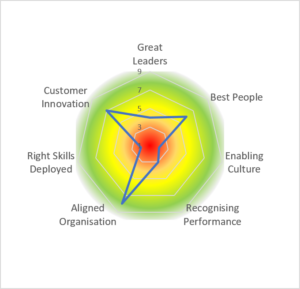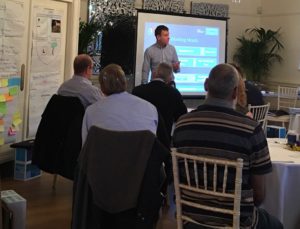Productivity through People

I had a great day yesterday at BaE’s new Skills and Learning Academy at their Samlesbury site – a truly stunning lean lifelong learning facility. I was with leaders from 24 of the North West’s finest SMEs. We spent the day assessing how their business stacks up against the best. The Productivity through People (PtP) leadership programme is based on the findings of the Better Working Practice group, championed by BaE, Rolls-Royce and Siemens. The Assessment is intensive but practical and we have tailored it at Lancaster University Management School (LUMS) to rigorously examine seven key aspects relating to people and organisations. These critical areas are chunked below; however, they should be viewed as inter-related. Together, they are proven to demonstrate what really matter in driving productivity.
1. Great Leadership is key. We considered the importance of the standards that leaders set, the shadow they cast. Great leaders actively listen, encourage two-way communication, they seek and act on employee input. They provide direction and context and align priorities by explaining why it is important for business success. They appreciate the value of their first line leaders and they invest in their capability, so that decisions can be made at the lowest possible level. Confident leaders display humility and vulnerability and don’t believe they know it all. They do not pretend to have all the answers.
2. We explored the importance of an Enabling Culture. Ethical standards need to be clear and visible –leaders should be seen to challenge and deal with poor behaviour… and be open to being challenged themselves. Employees need to feel it’s safe to speak up and what they have to say will be dealt with in a timely manner. They trust their leaders to do what they say they are going to do, they feel safe and respected. They see that all employee contributions are encouraged, and they can do their best and develop further – it’s worth sticking around. Constructive challenge is valued by all and leads to better decisions, in the diverse teams they work in.
3. We looked in detail at the relationship between Customer Innovation and employee engagement, requiring us to consider how well our employees understand what the customer values, and importantly, how leaders encourage employees to continually improve value through their products and services to customers. We also looked to each other, to see how much we presently leverage best practice and how each of us capture, share and retain the knowledge in our organisations. We reflected on how well we understood what help and support was available outside our organisations in support of innovation, through research and development grants and support for growth.
4. Great leaders understand how to acquire, develop and retain employees to ensure that they have the Best People to meet their needs now, and in the future. To ensure this, we tested our level of understanding of the nature and type of planning required – great talent doesn’t just happen. It is nurtured over time, by leaders that understand the aspiration of emerging diverse leaders. They patiently mentor, coach and challenge and they provide learning opportunities for growth and stretch, whilst providing ‘air and ground cover’ to try new things and learn from mistakes. We appreciated the business need for robust succession planning, and that it should not just be left to chance. We reminded ourselves that the data typically shows, that employees leave their leaders not organisations. Diverse role models are so important.
5. We saw how great performing companies are good at Recognising Performance and contribution. It is about being financially competitive and fair. It is important to align variable pay to what matters and to consider how it’s achieved. This is almost a given; however, we also demonstrated how easy it is to inadvertently create inequality through a gender pay gap. Without exception, the best leaders are great at saying… Thank You. They recognise that it’s their employees that matter most in getting sustainable results and they take joy in recognising their peoples’ achievements and celebrating their contribution.
6. Effective Skills Utilisation is a key characteristic of high value successful businesses. The best organisations understand how they add value for customer, through their people’s skills. They plan their critical skill requirements for now, and the future. They anticipate emerging themes and they prepare for disruption, from wherever it may come. They understand what skills they can acquire from outside and what capability they need to take accountability for to grow. These leaders are adept at deploying the critical skills they have with agility and flexibility. They don’t allow operational peaks and troughs to constrain their ability to deliver quality products and services to the customer. They meet their customer commitments.
7. Finally, we considered whether we have an Aligned Organisation and the lean operational processes to deliver value to the customer. This goes well beyond an organisation chart. We examined decision making rights and levels, the agility of the organisational structure and its ability to support leaders to rapidly respond to uncertainty and change. We also looked at the role of cross-functional teams that transcend traditional organisational barriers. They can be the source of organisational strength by improving systemic decision quality, in support exciting new products and services and ensure flawless operational execution.
The group were terrific and we covered a lot of stuff, in a long day and we all learned from each other. We have now gone back our businesses to reflect. Many will share what we did and hopefully some will deploy a few ‘quick wins’ from best practice sharing. This first cohort will use their assessment insights to tailor their personal learning through the LUMS PtP programme. I am sure they will prioritise their action planning to drive the bottom line productivity in their businesses. I wish them luck as they continue their journey next week as the pilot PtP programme at LUMS gets into full swing.
The Assessment Framework

Sean


Recent Comments